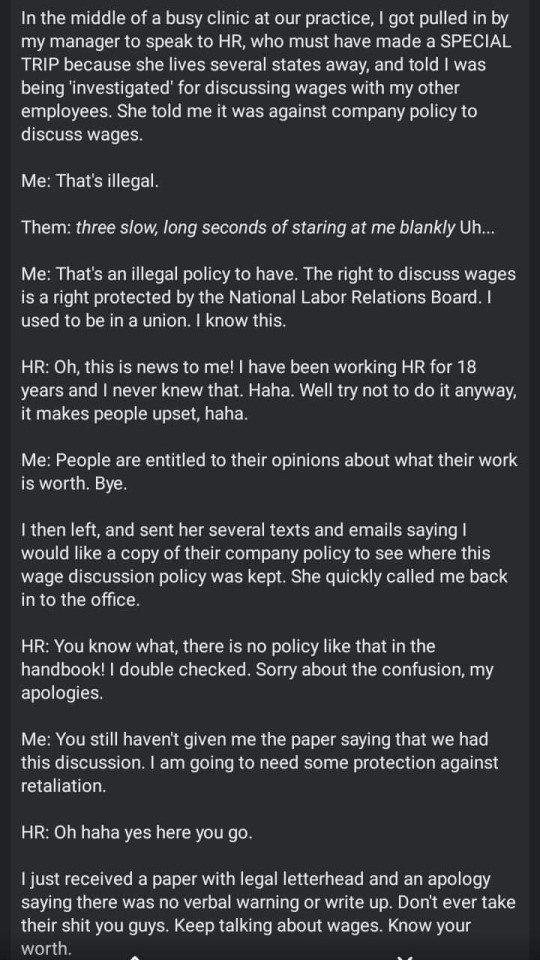#HR Department
Explore tagged Tumblr posts
Text
The real reason he burnt down the village








Let's face it, we all know HR would have actually been the one to drive him off the deep end, not the dusty books of Nibelheim.
#final fantasy 7#ff7#video games#final fantasy#final fantasy vii#Sephiroth#Tseng#HR Department#fanart?#fan edit#ff7 remake#ff7 crisis core#crisis core reunion#final fantasy 7 ever crisis#this is a joke#but seriously#I had HR pull some weird stuff on me too#everyone is a snowflake but also we must treat all cases the same#meaning you do not get treated properly for your unique situation#lol bitter#fml#I could keep going
167 notes
·
View notes
Text

9 notes
·
View notes
Text
Should You Trust Your Human Resources Department?
From Catbert the Evil Director of Human Resources to Office Space‘s The Bobs, HR as an institution has a less than stellar reputation. Some consider it downright evil.
But why? Why does HR get such a bad rap? Especially when they’re supposedly set up to provide employees with recourse against shitty coworkers and a direct pipeline to the EEOC?
Is HR really all that evil? And more importantly… should you trust them?
Keep reading.
If you found this helpful, consider joining our Patreon.
35 notes
·
View notes
Text

she thinks its sooooo funny when her coworker slaps her at work, but this is WRONG. you should tell HR if somenoe is slapping you at work, even if it makes you tingle and giggle. this is inappropriate behavior as your coworkers should be Punching and Killing You instead. none of that pansy shit.
2 notes
·
View notes
Text
The djd doubles as the decepticon hr department
#(cr department?)#cybertronian resources department#djd#decepticons#hr#hr department#cr department#transformers#decepticon justice division#lol
8 notes
·
View notes
Text

#workforce Wednesday#workforce#workforce development#formerly incarcerated#background#background checks#employment#employers#employees#opportunity#opportunities#human resources#hr#hr department#hr professionals#give people a chance#chances#choices#choice#reality#life#lessons#lesson#life lessons#life lesson#lessons in life#lesson in life#second chances#deserving#deserve
0 notes
Text
What’s the Point of HR? A Satirical Exploration of Corporate Babysitting
Ah, the HR department. The mysterious entity lurking in the depths of every office, shrouded in bureaucracy and powered by an inexhaustible supply of vague policies and passive-aggressive emails. Officially, HR (Human Resources, for those who still believed it stood for “Helpful and Reasonable”) exists to support employees, foster workplace harmony, and ensure fair treatment. In reality, it…
#bureaucracy#corporate culture#corporate nonsense#employee experience#HR#HR department#human resources#office politics#professional life#toxic workplaces#work humour#workplace satire
0 notes
Text
How a Strong HR Department Shapes Company Culture and Drives Success

In today's fast-paced business world, a vital Human Resources (HR) department is pivotal in cultivating a thriving company culture. At McGrant Tax & Bookkeeping, effective HR management can be the foundation for a successful business by fostering a positive work environment, enhancing productivity, and driving long-term growth. This article explores how a robust HR department can shape company culture and contribute to success.
The Role of HR in Establishing Core Values and Company Mission
HR is responsible for aligning employees with the company’s mission and values, which creates a unified sense of purpose. This alignment influences how employees interact with each other and clients, promoting a culture that mirrors the organization’s goals. McGrant emphasizes that instilling a strong sense of purpose among employees is foundational for fostering loyalty and motivation across the team.
Building a Positive Work Environment through Employee Support and Development
Employees feel supported, understood, and valued in a productive work environment. HR departments prioritizing open communication, employee development, and well-being can significantly improve workplace morale. From structured onboarding processes to continuous learning opportunities, HR is crucial in nurturing a supportive atmosphere that keeps employees engaged and motivated.
HR’s Role in Conflict Resolution and Maintaining Workplace Harmony
Conflicts are inevitable in any workplace. A strong HR team addresses issues promptly and impartially, ensuring minor disputes do not escalate. This proactive approach is crucial for preserving a harmonious work environment and helping employees work collaboratively without prolonged tension. McGrant’s HR consulting services focus on effective conflict resolution techniques, essential for small businesses aiming to maintain team cohesion.
Enhancing Employee Engagement and Satisfaction through Regular Feedback
Regular feedback and performance reviews are vital for maintaining high levels of employee satisfaction. HR departments that actively seek employee feedback can identify areas for improvement and make informed decisions. This feedback loop contributes to an engaged workforce that feels valued and heard, fostering a culture of openness and mutual respect.
Driving Success by Focusing on Compliance and Fairness
Ensuring compliance with labor laws and promoting fairness in hiring and employee treatment are crucial HR functions. A strong HR team keeps the organization compliant with regulations and mitigates risks associated with legal issues. At McGrant, we understand that a fair and lawful work environment forms the basis of trust, attracting top talent and promoting a reputation of integrity.
A well-structured HR department does more than manage administrative tasks; it shapes a company's culture. By aligning with the company's values, fostering open communication, and supporting employee development, HR departments create an environment where employees are motivated to contribute their best work. At McGrant Tax & Bookkeeping, we emphasize the importance of HR as a strategic driver of success, guiding businesses toward sustainable growth and a robust and supportive company culture.
McGrant Tax & Bookkeeping 2340 N Graham Street Charlotte , NC , 28206 (704) 343-9949 www.mcgranttax.com
0 notes
Text
My boss tried telling someone that it was against policy to discuss salary a few months ago... they have a degree in management and I work for a law firm. Don't underestimate an employer's capacity to pull shady shit. I'm pretty sure the only reason a few of us knew it was illegal was because we saw it on tiktok.

Do Not Let HR do this to you. It is not illegal to talk about wages in the work place. I did and got a 12% raise!
73K notes
·
View notes
Text
Dear HR,
Please stop ghosting me, I'm not your toxic ex.
Thank you.
0 notes
Text

First meeting
#stobotnik#doctor ivo robotnik#agent stone#sonic movie universe#i hope you all are noticing what i'm doing with stone's clothes specifically#white shirt pre robotnik black to fit his goth boss then colors when ivo starts wearing red#also i know we all like to think robotnik hated being assigned an agent but i present to you:#he sees it as a symbol of status kinda. stone hates being here#it just feels right to me. it's not that robotnik thinks the agent will be useful at all#he's just pleased that he got one#everyone else has an assistant why shouldn't he?#this ties to a very very stupid headcanon i have#and it's that robotnik's blood type is O negative#HEAR ME OUT he would hate that. he would hate being an universal donnor because he doesn't care about saving lives of humans ew#but then stone is also O negative so that means robotnik can receive blood from him if necessary#and that's mostly the reason why he was chosen to be his assistant#ivo is too important to die! and O negative blood isn't that common#Stone knows but probably no one told robotnik#then of course imagine stone getting injured and needing blood and ivo is like wait i can do that it doesn't matter what his blood type is#you get the point#i think. i'm pretty sure there was a point#oh well#oh the no hr joke. they're a shady goverment organization i don't think they treat their people that well#that being said maybe robotnik's treatment of stone was the reason they had to get an hr department who knows
5K notes
·
View notes
Text
DMS Blog 1 Top 5 Key Features Using Document Management Software for an HR Department
SEO Meta-Description: Explore the top 5 key features that a document management software offers for enhancing HR department efficiency, including secure access control, document version control, integration with HR systems, compliance, and more.
Introduction
Managing documents efficiently is crucial for HR departments to streamline operations and enhance productivity. Document management software plays a pivotal role in achieving these goals by offering a range of key features tailored for HR needs.
What is Document Management Software?
Document Management Software (DMS) is a digital solution designed to organize, store, and track documents and information digitally. It eliminates the need for paper-based document handling and provides a centralized platform for managing HR-related documents.
Importance in HR Departments
For HR departments, DMS is indispensable as it simplifies document handling, reduces errors, ensures compliance with regulations, and enhances data security and confidentiality.
Benefits for HR Operations
Implementing DMS in HR operations brings numerous benefits, including improved efficiency, faster document retrieval, better collaboration among team members, reduced costs associated with manual paperwork, and enhanced data accuracy.
Challenges in HR Document Management
Despite its benefits, HR document management comes with challenges such as data security concerns, compliance requirements, document version control issues, and ensuring seamless integration with existing HR systems.
Key Feature 1: Secure Access Control
User Permissions: DMS allows HR admins to assign specific access permissions to users based on their roles and responsibilities, ensuring data confidentiality and preventing unauthorized access.
Role-Based Access: With role-based access control, HR staff can access only the information relevant to their roles, maintaining data integrity and confidentiality within the organization.
Audit Trails: DMS generates audit trails that track document access, modifications, and activities, providing transparency and accountability in document management processes.
Key Feature 2: Document Version Control
Version History: DMS maintains a detailed version history of documents, allowing HR teams to track changes, revert to previous versions if needed, and ensure document accuracy and compliance.
Revision Tracking: The software tracks revisions made to documents, including who made the changes and when, facilitating collaboration while maintaining version control.
Key Feature 3: Document Search and Retrieval
Full-Text Search: DMS enables HR professionals to perform full-text searches across documents, making it easy to locate specific information quickly and efficiently.
Metadata Tagging: By tagging documents with metadata such as keywords, categories, and tags, DMS enhances searchability and categorization, improving document retrieval processes.
Key Feature 4: Integration with HR Systems
Seamless Data Exchange: DMS seamlessly integrates with existing HR systems, allowing for automated data exchange, synchronization of employee records, and streamlined workflows.
Automated Workflows: Integration with HR systems enables automated workflows for tasks such as employee onboarding, performance reviews, and compliance checks, improving HR efficiency.
Key Feature 5: Compliance and Security
Data Encryption: DMS employs robust encryption techniques to protect sensitive HR data, ensuring compliance with data protection regulations and safeguarding against data breaches.
Compliance Checks: The software conducts compliance checks to ensure HR documents adhere to regulatory requirements, helping organizations avoid legal risks and penalties.
Disaster Recovery: DMS includes disaster recovery features such as data backup, recovery options, and continuity planning, minimizing data loss and downtime during unforeseen events.
FAQs
How does Document Management Software improve HR efficiency?
Document Management Software automates document handling, enhances collaboration, ensures data security, and streamlines workflows, leading to improved HR efficiency.
What are the key security features of Document Management Software?
Document Management Software offers features like data encryption, access control, audit trails, compliance checks, and disaster recovery to ensure robust security for HR documents.
Can Document Management Software integrate with other HR systems?
Yes, Document Management Software can seamlessly integrate with existing HR systems, enabling automated data exchange, workflow synchronization, and enhanced operational efficiency.
How does Document Version Control benefit HR departments?
Document Version Control enables HR departments to track document changes, maintain version history, ensure compliance, and collaborate effectively while maintaining data accuracy.
What compliance regulations does Document Management Software adhere to?
Document Management Software adheres to various compliance regulations such as GDPR, HIPAA, SOX, and industry-specific standards, ensuring data protection and regulatory compliance.
How does Document Management Software enhance document search and retrieval?
Document Management Software offers full-text search capabilities, metadata tagging, advanced search filters, and categorization features, making document search and retrieval efficient and accurate.
Conclusion
In conclusion, Document Management Software provides HR departments with essential tools to streamline document management, enhance collaboration, ensure data security and compliance, and improve overall operational efficiency. By leveraging the top 5 key features discussed, HR professionals can optimize their workflows, mitigate risks, and focus on strategic HR initiatives.
<a href="https://www.nte.ai/Blog/business/dms-blog-1-top-5-key-features-using-document-management-software-for-an-hr-department/ ?utm_source=backlink&utm_medium=directory+submission&utm_campaign=organic">Visit nte.ai</a>
0 notes
Text
Key Areas Covered by the HR Department
Introduction:
The Human Resources (HR) department plays a pivotal role in the success and well-being of any organization. Its multifaceted responsibilities encompass a wide range of areas, all aimed at managing and developing the most valuable asset — the workforce. In this blog, we'll explore the essential areas covered by the HR department, shedding light on their significance in fostering a productive and harmonious work environment.
1. Recruitment and Staffing:
One of the primary functions of HR is to attract, hire, and retain top talent. This involves developing recruitment strategies, conducting interviews, and managing the onboarding process for new hires.
2. Employee Relations:
HR is responsible for cultivating positive relationships between employees and the organization. This includes addressing workplace conflicts, conducting employee satisfaction surveys, and ensuring a healthy work culture.
3. Compensation and Benefits:
The HR department administers compensation and benefits programs, ensuring fair and competitive pay structures. They manage employee benefits such as health insurance, retirement plans, and other perks.
4. Training and Development:
To enhance employee skills and knowledge, HR oversees training and development programs. This involves identifying training needs, organizing workshops, and providing opportunities for professional growth.
5. Performance Management:
HR is involved in setting performance standards, conducting evaluations, and providing feedback to employees. They play a crucial role in performance appraisals and addressing issues related to underperformance.
6. Legal Compliance:
Ensuring compliance with employment laws and regulations is a critical function of HR. This includes staying updated on labor laws, handling legal documentation, and mitigating risks associated with employment-related lawsuits. Among the areas covered by the HR department this one is the most crucial.
7. Diversity and Inclusion:
HR promotes diversity and inclusion within the workplace. They implement strategies to foster a diverse workforce, address biases, and create an inclusive environment that values differences.
8. Employee Engagement:
To boost morale and productivity, HR focuses on employee engagement initiatives. This includes organizing events, fostering a positive work culture, and creating opportunities for team-building.
9. HR Information Systems (HRIS):
Managing HRIS is integral for handling employee data, payroll, and other HR-related information. HRIS ensures accurate record-keeping and supports data-driven decision-making.
10. Health and Safety:
Ensuring a safe and healthy work environment is a priority for HR. They develop and implement safety protocols, handle workplace accidents, and promote employee well-being is on of the essential areas covered by the HR department.
FAQs:
Q1: What role does HR play in conflict resolution?
A1: HR acts as a mediator in resolving workplace conflicts, providing a neutral ground for employees to voice concerns and facilitating solutions that align with company policies.
Q2: How does HR contribute to employee development?
A2: HR identifies skill gaps, organizes training programs, and supports career development initiatives to enhance the capabilities and growth of employees.
Q3: Why is diversity important in HR initiatives?
A3: Diversity fosters innovation and creativity, and HR initiatives that embrace diversity contribute to a more inclusive workplace, improving employee satisfaction and overall organizational success.
Conclusion:
The areas covered by the HR department serves as the backbone of an organization, contributing to its success by managing various facets of human capital. From recruitment to employee engagement, HR plays a crucial role in creating a dynamic and thriving workplace. Understanding and appreciating these key areas is essential for organizations aiming to build a resilient and motivated workforce.
1 note
·
View note
Text
Drafting a new cannabis policy, let's get into it.
With few exceptions (mostly heavily regulated industries- check your local laws) employees in the private sector are protected from discrimination based on legal (you gotta be 21) recreational cannabis use during their own time, off the employers premises and without use of company equipment (sorry, you can't hot box the company truck).
This includes at hiring, most companies have stopped testing for cannabis all together. It's illegal in NYC.
If you live in a state without legal weed you are SOL.
What about medical?
That's a bit more complicated but in general it should be treated like any other mind-altering prescription.
What about post-accident or reasonable suspicion testing?
This is where they're going to get you. Best practice is to use a cheek swab to narrow the window of use. It's not required so you still may get sent for a piss test, pop hot, and get fired.
Consider getting a med card to bolster a wrongful terminated suit.
It'll be interesting to see how this plays out in the courts.
How can you protect yourself?
Get a medical card. Even in a recreationally legal state. Doing so will guarantee your privacy at hiring. If you test positive on a pre-employment test the medical review office will reach out to you to confirm if you have an Rx, if you do they'll return the results as negative to your employer.
Read the company policy.
During the interview process its totally appropriate to ask “what is the onboarding process?”. If the recruiter seems cool you can ask them more directly (OVER THE PHONE. Don't put that shit in writing)
#your boss is not your friend#hr is not your friend#human resources#career advice#hr#know your rights#workers rights#employment law#hr department#cannabis#cannabiscommunity#cannablr#not legal advice
1 note
·
View note
Text
In today’s rapidly evolving business landscape, human resources (HR) practices are pivotal to the success of any organization. Two essential documents that often play a crucial role in HR management are the HR manual and the employee handbook. While they might seem similar at first glance, they serve distinct purposes and have unique characteristics. In this blog, Metaphrasis delve into the key differences between an HR manual and an employee handbook, shedding light on their significance in the workplace.
Understanding the HR Manual
Definition and Purpose
An HR manual, short for Human Resources manual, serves as an internal document created by the HR department. Its primary purpose is to guide HR personnel in the execution of their duties and responsibilities.
Content
The HR manual contains comprehensive information on HR policies, procedures, and practices specific to the organization. It covers aspects such as recruitment, onboarding, performance management, and employee relations.
Audience
The primary audience for the HR manual is the HR team itself. It acts as a reference guide for HR professionals, ensuring consistency and adherence to organizational HR policies.
Confidentiality
HR manuals typically contain sensitive information and are often considered confidential documents. Access to the HR manual is restricted to HR staff and authorized personnel.
Legal Compliance
HR manuals are designed to ensure that the organization complies with labor laws and regulations. They provide guidelines for fair employment practices and ethical conduct.
Unpacking the Employee Handbook
Definition and Purpose
An employee handbook, on the other hand, is a document created by HR for the benefit of all employees. Its primary purpose is to communicate company policies, procedures, and expectations to the workforce.
Content
The employee handbook encompasses a wide range of topics, including but not limited to company culture, code of conduct, benefits, leave policies, and disciplinary procedures.
Audience
Unlike the HR manual, the employee handbook is intended for all employees within the organization. It serves as a valuable resource for employees to understand their rights and responsibilities.
Accessibility
Employee handbooks are typically made accessible to all employees, either in print or electronically. They are often provided during the onboarding process and can be referenced at any time.
Legal Protection
Employee handbooks can also serve as a form of legal protection for the organization. They establish clear guidelines, reducing the risk of misunderstandings and potential legal disputes.
Bridging the Gap
Collaboration
While HR manuals and employee handbooks have distinct roles, they can complement each other. HR professionals should collaborate to ensure that the information in both documents aligns seamlessly.
Updates
Both documents require regular updates to stay current with evolving laws and organizational changes. HR teams should work together to maintain accuracy.
Communication
HR teams should communicate effectively to ensure that policies outlined in the employee handbook are in line with the procedures detailed in the HR manual.
Conclusion
In summary, the HR manual and the employee handbook are essential tools for HR management, but they serve different purposes. The HR manual primarily guides HR professionals in their day-to-day activities, ensuring compliance with legal requirements. On the other hand, the employee handbook acts as a communication tool for all employees, providing them with information on company policies and procedures.
#Employee#Employee Handbook#HR Department#HR Management#HR Manual#human resources#Human Resources Manual
0 notes